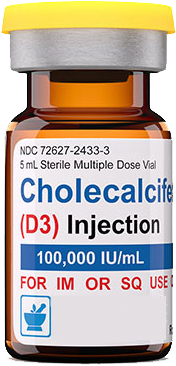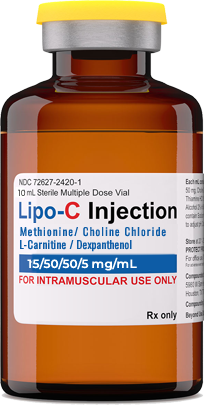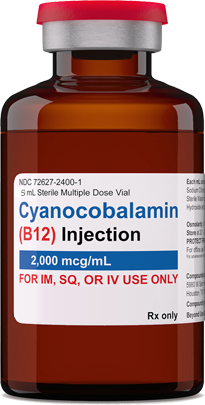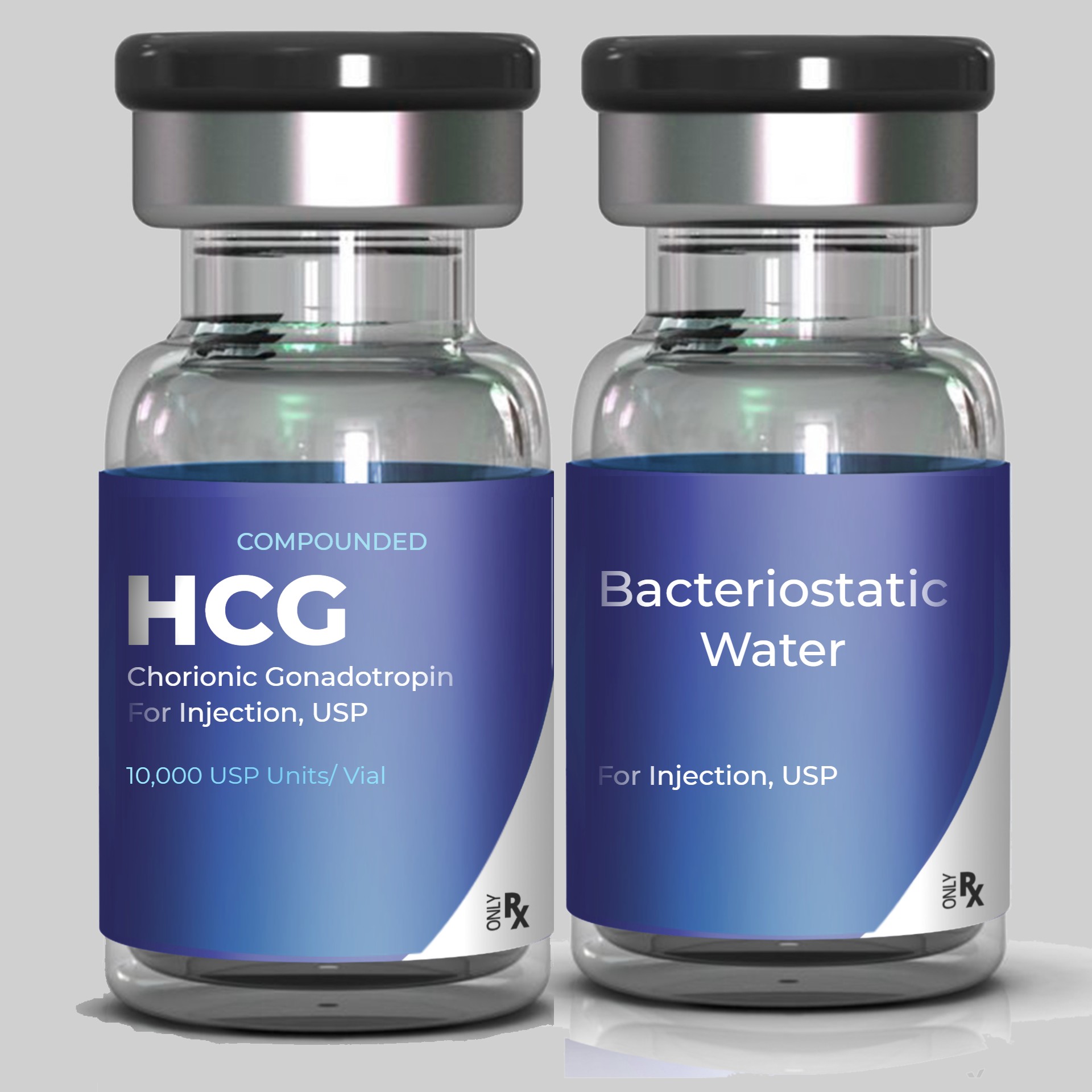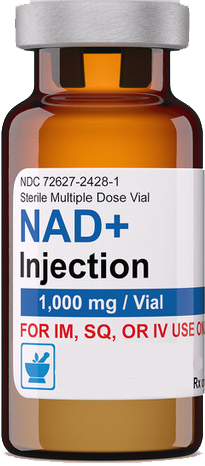Mechanism of Action
Cholecalciferol is metabolized to its active form, calcitriol (1.25-dihydroxyvitamin D); all vitamin D activity is due to this metabolite. Calcitriol promotes renal reabsorption of calcium, increases intestinal absorption of calcium and phosphorus, and increases calcium mobilization from bone to plasma. Calcitriol promotes intestinal absorption of calcium through binding to a specific receptor in the mucosal cytoplasm of the intestine. Subsequently, calcium is absorbed through formation of a calcium-binding protein. The synthesis of calcitriol is enhanced by elevated parathyroid hormone levels and low plasma phosphorus levels. Hypocalcemia causes release of parathyroid hormone, which stimulates the production of calcitriol.
The vitamin D receptor (VDR) is present in numerous tissues throughout the body; the exact action of calcitriol within these tissues is not completely understood. There is evidence that calcitriol plays a role in the immune system. Calcitriol has been shown to inhibit cancer growth and stimulate cell differentiation.
Precautions
Clinically, cholecalciferol is similar to ergocalciferol; therefore, clinicians should also take contraindications and precautions for ergocalciferol into consideration when initiating cholecalciferol therapy.
Cholecalciferol should not be used in patients with hypercalcemia, hypervitaminosis D, and vitamin D hypersensitivity or hypersensitivity to any of the excipients in the formulation. Hypersensitivity to vitamin D is one etiologic factor in infants of idiopathic hypercalcemia where vitamin D intake must be restricted.
Patients with renal disease, especially renal failure, may be at increased risk for vitamin D-induced hypercalcemia even with usual dosages. Close clinical monitoring is needed to ensure adequate supplementation and, in pediatric patients, proper growth. In patients with stage 3 or higher kidney disease, use of a vitamin D analog appears preferred, following recommendations of the National Kidney Foundation.
Patients with fat malabsorption due to malabsorption syndrome, cystic fibrosis, Crohn’s disease, some forms of hepatic disease, gallbladder disease or biliary tract disease may require higher doses of vitamin D due to decreases in intestinal absorption. Some patients taking concurrent medications (e.g., certain anticonvulsants) may require higher doses as well. The prescription of active vitamin D analogs may be preferred in such cases.
Ergocalciferol (Vitamin D2) is classified as FDA pregnancy risk category C; dietary supplements of cholecalciferol should be treated similarly with respect to pregnancy. Adverse effects have not been reported with the normal daily intake of Vitamin D within the recommended dietary daily intakes for a pregnant female. Animal reproduction studies have shown fetal abnormalities in several species associated with hypervitaminosis D; therefore, the use of vitamin D in excess of the recommended dietary allowance during normal pregnancy should be avoided unless, in the judgment of the physician, potential benefits outweigh the hazards involved. The RDI of vitamin D during pregnancy is 600 International Units/day with a Tolerable Upper Intake Limit of 4000 International Units/day.
The 25-hydroxyvitamin D metabolite of vitamin D (cholecalciferol) is distributed into human breast milk at concentrations relative to the maternal serum concentration. Typical breast milk concentrations (without maternal supplementation) are not sufficient to prevent vitamin D deficiency in infants that are exclusively breast-fed and do not receive other vitamin D supplementation. Prolonged, exclusive breast-feeding of infants without recommended supplementation is a significant cause of rickets in infants, especially in dark-skinned infants breast-fed by mothers who are not vitamin D replete. Use of vitamin D within the recommended daily dietary intake for lactating women is generally recognized as safe. The recommended daily allowance of vitamin D during breast-feeding is 600 International Units/day with a Tolerable Upper Intake Limit of 4000 International Units/day. While high-dose vitamin D supplementation to nursing mothers has been shown to increase the concentration of vitamin D in breast milk and favorably increase 25(OH)D levels in infants, the results have not been validated and supplementation to infants is still recommended.5 Generally, the serum calcium concentrations of the infant should be monitored when a nursing mother is prescribed vitamin D in high doses, since hypercalcemia has been reported with high dose maternal use.
Pregnancy
Ergocalciferol (Vitamin D2) is classified as FDA pregnancy risk category C; dietary supplements of cholecalciferol should be treated similarly with respect to pregnancy. Adverse effects have not been reported with the normal daily intake of Vitamin D within the recommended dietary daily intakes for a pregnant female. Animal reproduction studies have shown fetal abnormalities in several species associated with hypervitaminosis D; therefore, the use of vitamin D in excess of the recommended dietary allowance during normal pregnancy should be avoided unless, in the judgment of the physician, potential benefits outweigh the hazards involved. The RDI of vitamin D during pregnancy is 600 International Units/day with a Tolerable Upper Intake Limit of 4000 International Units/day.
Breast Feeding
The 25-hydroxyvitamin D metabolite of vitamin D (cholecalciferol) is distributed into human breast milk at concentrations relative to the maternal serum concentration. Typical breast milk concentrations (without maternal supplementation) are not sufficient to prevent vitamin D deficiency in infants that are exclusively breast-fed and do not receive other vitamin D supplementation. Prolonged, exclusive breast-feeding of infants without recommended supplementation is a significant cause of rickets in infants, especially in dark-skinned infants breast-fed by mothers who are not vitamin D replete. Use of vitamin D within the recommended daily dietary intake for lactating women is generally recognized as safe. The recommended daily allowance of vitamin D during breast-feeding is 600 International Units/day with a Tolerable Upper Intake Limit of 4000 International Units/day. While high-dose vitamin D supplementation to nursing mothers has been shown to increase the concentration of vitamin D in breast milk and favorably increase 25(OH)D levels in infants, the results have not been validated and supplementation to infants is still recommended. Generally, the serum calcium concentrations of the infant should be monitored when a nursing mother is prescribed vitamin D in high doses, since hypercalcemia has been reported with high dose maternal use.
Side Effects
In general, the use of supplemental vitamin D according to recommended dietary intakes is not associated with serious adverse reactions. Vitamin D may cause side effects in overdose, but such symptoms associated with hypervitaminosis D (and resultant hypercalcemia) are rarely reported. An excess of vitamin D causes abnormally high levels of calcium in the blood and is almost always caused by vitamin D analogs (e.g., calcitriol, doxercalciferol, paricalcitol), rather than vitamin D found in dietary supplements (e.g., cholecalciferol, ergocalciferol). However, patients taking higher doses of vitamin D supplements should report any of the following potential signs of high vitamin D/calcium concentrations: nausea/vomiting, constipation, loss of appetite, increased thirst (polydipsia), increased urinary frequency, mental/mood changes or irritability, headache, unusual fatigue or tiredness. These symptoms may require clinical evaluation. Anorexia, weight loss, polyuria, and arrhythmias may also be observed. In addition, hypercalcemia due to bone resorption leading to hypercalciuria may be observed in prolonged hypervitaminosis D. In early stages of vitamin D toxicity, hypercalcemia is mild and renal function remains normal. As vitamin D toxicity continues, continued bone resorption and increased calcium levels lead to suppression of parathyroid production. Calcification of the vasculature and other tissues has been associated with prolonged vitamin D toxicity. Data do not support that vitamin D toxicity is associated with kidney stones. Death due to vitamin D intoxication is likely due to renal and cardiovascular failure. Long-term doses of vitamin D of 10,000—40,000 International Units/day and long-term serum 25(OH)D concentrations of 500—600 nmol/L (200—400 ng/mL) are associated with vitamin D toxicity. Symptoms of vitamin D toxicity can become apparent within 4 weeks of continual excessive ingestion. Due to the long half-life of vitamin D, symptoms of toxicity may be prolonged. Excessive sun exposure does not result in vitamin D toxicity.
Risk of growth inhibition in infants due to vitamin D supplements is based on a 1938 report of 35 infants up to 45 weeks of age where high-dose vitamin D supplementation (1800—4500 International Units/day for 6 months) was associated with growth inhibition in comparison with lower dose vitamin D supplements (< 340 International Units/day for 6 months). In a subsequent but smaller study (n=11) performed in 1966, no association between vitamin D supplements and growth inhibition was found. However, due to a possible association, no RDI for vitamin D has been set for infants.2 A large observational study from Finland in 2011 reported no association between growth inhibition later in life (as evaluated at 14 and 31 years of age) and the administration of vitamin D supplements (2000 International Units/day) during infancy.
Storage
Store this medication at 68°F to 77°F (20°C to 25°C) and away from heat, moisture and light. Keep all medicine out of the reach of children. Throw away any unused medicine after the beyond use date. Do not flush unused medications or pour down a sink or drain.

